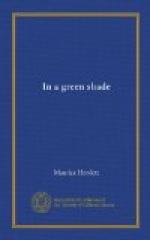One or two variations from modern practice may be noted. The Elizabethan husbandman grew, I have said, his own flax and hemp; he grew his vines too, and Tusser bids him prune them in February. I, who grow mine, call that full early. He does not tell us when he gathered his grapes or (what I very much want to know) how he made his wine—whether with pure fermented grape-juice, which is the French way, or by adding water and sugar to the must, which is our present English fashion. Again, he used sheep’s milk both for draught and for butter-making. I wish we had sheep’s milk butter. No one who has had it in Greece would be without it at home if he could help it. You weaned the lambs at Philip and Jacob, he says, if you wanted any milk from the ewe. Lastly, he grew saffron, which he pared between the two St. Mary’s days. To pare is to strip the soil with a breast-plow. The two St. Mary’s days were July 22 and August 15, which would be a pretty good time to plant saffron.
We also, in my country, date our operations by holy days, long after the holy men have ceased to be commemorated. Who knows St. Gregory’s Day? It is March 12. Marrowfat peas go into the drill:
Sow runcivals timely, and all that is
grey;
But sow not the white till St. Gregory’s
Day.
I will undertake that half a dozen old hands round about my house follow out this rule in its entirety.
FLOWER OF THE FIELD
A county inquiry took me, one day last summer, deeply into the Plain, up and over a rutty track which my driver will have cause to remember. An uncommonly large hawk soaring over his prey, and so near the ground that I could see the light through his ragged plumes, a hare limping through the bents, further off a crawling flock bustling after shepherd and dog, were all the living things I saw. The ground was iron, the colour of what had once been herbage a glaring brown. Of the flowers none but the hardiest had outlived the visitation of the sun. I saw rest-harrow which has a root like whipcord, and the flat thistle which thrives in dust. The harebells floated no more, the discs of the scabious were shrivelled husks; ladies’ bedstraw was straw indeed, but not for ladies’ uses. Three miles away from anywhere we came upon a clump of dusty sycamores whose leaves were spotted and beginning to fall; beyond them was a squat row of flint and brick bungalows, the goal of our quest. There were three tenements, of which two were empty. In the third lives the shepherd who had called me up to consider his circumstances.




